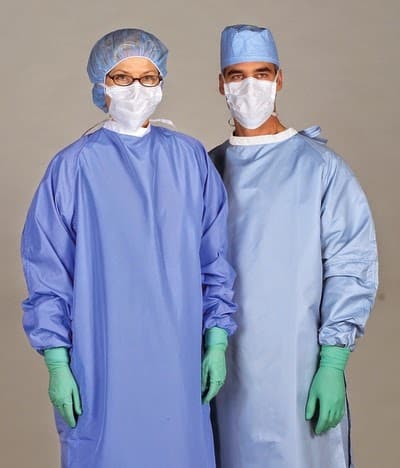Woven Fabrics
The formal structure of a woven fabric is defined by weave, thread density, crimp and yarn count. Woven fabrics are made by using two or more sets of yarn interlaced at right angles to each other. Much variety is produced by weaving. Woven fabrics are generally more durable. A woven fabric which is used in clothing and garments or for decoration and covering purposes. Without these application woven fabric also used as sportswear, medical applications, textiles for electronics and airbag construction in automotive engineering.
Medical textiles
Woven medical textiles are typically used for products requiring extreme stability and; high durability over a significant number of loading cycles; or to precisely control porosity for air or fluid flow. For example, a good quality surgical gown must be made of light and comfortable, breathable fabric material, yet be tough and durable enough to withstand abrasion, ripping and puncture.
Medical textiles are the products and constructions used for medical and biological applications for clinical and hygienic purposes, scaffolds for tissue culturing and a large variety of prostheses for permanent body implants. They consist of all those textile materials used in health and hygienic applications in both consumer and medical markets. A broad classification of medical textiles can be as under:.
- Protective and healthcare textiles – surgical wear, operation dresses, staff uniforms, etc.
- External devices – wound dressings, bandages, pressure gauze, prosthetic aids, etc.
- Implantable materials – sutures, vascular grafts and artificial limbs are the products where textiles are used.
- Hygiene products – incontinence pads, nappies, tampons, sanitary towels, etc.
- Extracorporeal devices – artificial liver, artificial kidneys and artificial lung are the recent advances in medical textiles.
Automotive textiles
Automotive textiles are finding extensive use in the product categories of interior trims, safety devices such as seatbelts and airbags, carpets, filters, battery separators, hood liners, hoses and belt reinforcement.
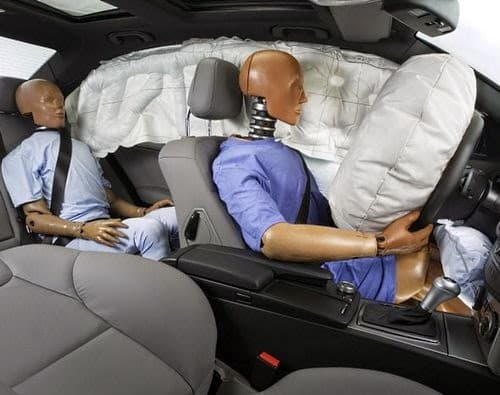 |
Filter fabrics
The surface quality of a woven fabric has become an increasingly important factor which influences the property of the filter in many different ways. Surface treatments modify the functionality of the woven fabric according to the different requirements and thereby significantly increase the effectiveness of the resulting filter in a specific environment.
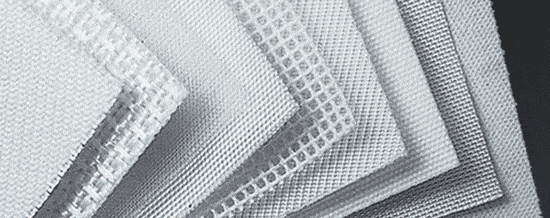 |
| Filter fabric |
Woven filters are used in many acoustic devices, loudspeakers and microphones. Filters not only improve the speech and sound quality in mobile phones by adsorbing unwanted frequency peaks; they also protect the sensitive electronic equipment from moisture, dust and dirt.
In automobiles, a series of filter systems are used to protect sensitive components. High precision woven fabrics are mounted in the fuel, injection and hydraulic filter systems.
Textiles for electronics
E-textile technology holds out the promise of truly wearable computers as well as inexpensive large-scale computational devices.
New fibers are being created for inclusion in e-textiles, including battery fibers, conductive fibers and mechanically active fibers. Methods are being developed for attaching discrete components to e-textiles, including processors, microphones and speakers. Two broad categories of e-textile applications are envisioned, wearable and large-scale non-wearable.
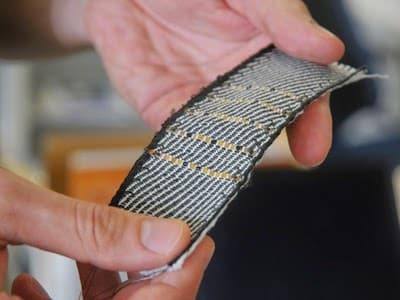 |
| Woven e-textile |
Many specific applications in the field of wearable computing have been envisioned and realized, though most suffer bulky form factors. In the new field of large-scale non-wearable e-textiles, applications include large-scale acoustic beam-forming arrays (STRETCH), self-steering parafoils (Draper) and intelligent, inflatable decoys (DARPA).
Sports textiles
Sport textiles are textiles used in sports. Woven fabrics are widely used in sports textile. These are sports goods and sportswear. Sportswear is clothing, including footwear, worn for sport or exercise. Typical sport-specific garments include short pants, tracksuits, and trainers. Specialized garments include wet suits and salopettes. It also includes some underwear, such as the jockstrap. Sportswear is also often worn as casual fashion clothing. For most sports the athletes wear a combination of different items of clothing, e.g. sports shoes, pants and shirts. Some athletes wear personal armour such as helmets or American football body armor.
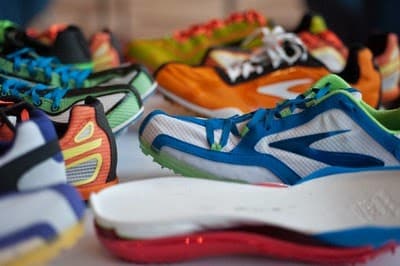 |
| Sports footwear |










